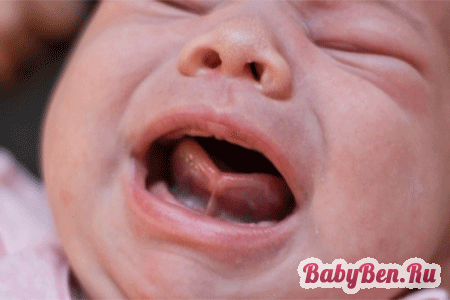
A short bridle in newborns often arises as a result of underdevelopment of the linked lintel. The late appeal to the clinic to eliminate innate anomalies at an early age contributes to the further development of speech defects, a change in bite, dental curvature.

The content of the article
Causes of anomaly
The main factor provoking pathology is hereditary predisposition. Parents who have such a manifestation in early childhood may notice such a defect and their child.
For reasons, the presence of ankilosses can also be attributed to the state of the woman during pregnancy, the state of her health, habits. If the woman was actively accepted hormonal drugs or antispasmodics in the first months after conception, it is likely that the baby will receive a shortened bridle of the language. An abdominal trauma in the period of toaling, age category after 40 years, the environmental factor of residence, stress, depressive attitude, too, can be the main causes of the development of a shortened membrane of the tongue in infants.
How to recognize a bridle defect?
The child's pathology without inspection of the oral cavity can be determined by such manifestations:
- If the baby begins to be capricious during feeding process. Without a full-fledged sucking function, food is impossible. In this case, the language is the main component for the reception of milk.
- If a child has anomalies in this area, most milk will flow back. This significantly affects its nutrition and leads to a slowdown in growth and development.
- The feeding process is delayed for a long time and has an infallible phase.

Checking the possible anomaly
The length of the tongue lintel in the infant should not be less than 8 mm. On visual features, you can understand the presence of a problem. To determine the pathology, delay the lower part of the baby's lips so that it opens. So you can see how the jumper is located and the place of its separation from the bottom gum. If the bridle holds the tongue at its base, and the edge itself does not reach the lip itself, then this is the correct indicator of the sublingual compound.
You can also determine the congenital anomaly in the form of a language. In this case, it has a boat form.
Conducting an operation
The cutting of the bridles is done after two weeks of life, since the operation in the future can become a more susceptible procedure. This factor is caused by the fact that blood vessels are located deeply and lead to the long section of the end of the bridle, connecting with the base of the tongue. After surgery, the complication does not occur practically. Healing contributes to maternal milk. In the future, the proper jumper will allow the full development of the kid's articulation apparatus.
The operation should not scare parents - it is the surgical procedure that will affect the further development and digestibility of food by a children's body. Operation to trim the bridle lasts a few minutes and is carried out without the introduction of anesthesia. Early intervention allows you to almost painlessly carry out manipulations, this is due to the informed nerve endings of the infant. A day after the operation, the incision begins to delay, the child eats well and adds in weight. The operation is better to carry out children under the age of the year.

If the shortened bridle of the oral cavity in the child, the parents found late, at the age of 3 years, it is necessary to visit an orthodontist doctor or a children's surgeon. Currently, short bridle is eliminated by using laser technology. This type of surgical intervention passes quickly and without pain. Healing passes without the imposition of seams and without the consequences for the health of the baby.
